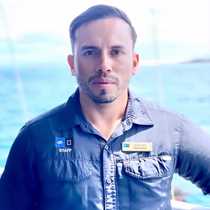Floreana Island (Cormorant Point, Champion Islet, Post Office Bay)
It is time for us explorers to learn about the human history of the Galápagos Islands, and understand about the very successful projects of the National Park Service, which has worked to eradicate the introduce species of the Galápagos and restore the dynasty of the endemic species unique to these enchanted islands.
Floreana was the first island to be inhabited by humans when the islands were claimed by Ecuador in 1832. Nowadays Floreana marks a very important piece of the human history of the islands from British whalers to buccaneers, privateers and famous pirates from the 17th century who navigated these waters in search of fresh water and giant tortoises as a source of meat.
During the morning we disembarked on a green sand beach (olivine), and as we walked further into the island we spotted some greater Flamingos (endemic subspecies) in a brackish water lagoon. We have very few flamingos in the islands, therefore we were lucky to spot some of them feeding on the brine shrimp. The trail took us to the other side of the cove to a beautiful white sandy beach known for being one of the preferred places of Pacific green sea turtles to make their nests.
Later on we explored the underwater world of Galápagos by snorkeling around Champion Islet (satellite islet of Floreana). Some white-tip reef sharks were spotted as well as plenty of playful sea lions performing a great show while swimming with us.
We also visited the famous barrel in Post Office Bay. About 50 yards from the shoreline a very rusty barrel is situated, a very easy but practical way to get in touch with the rest of the world, it was put here by captain James Cornett in 1792. Nowadays our guests leave their letters in hope that one day someone will take them and hand deliver them.
We kayaked around Floreana and had a great time spotting some striated herons, great blue herons and many sea lions colonies on the lava fields around Floreana.
This was another excellent day in Galápagos.




